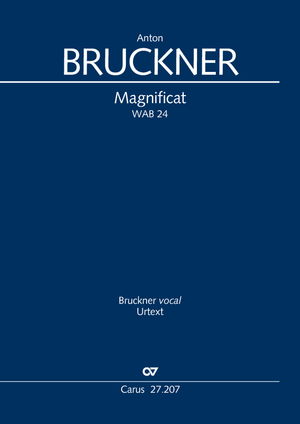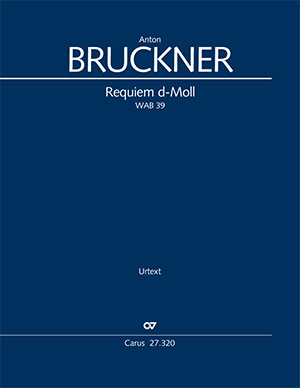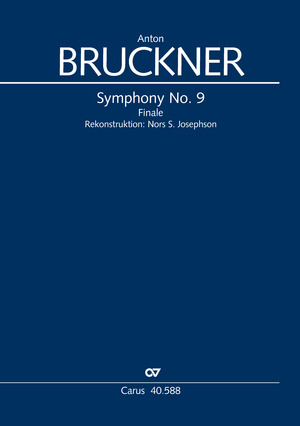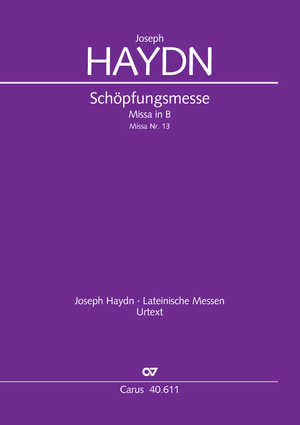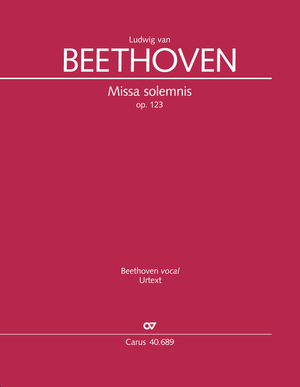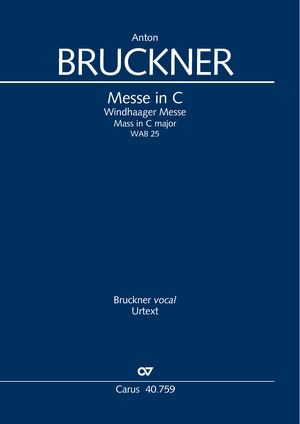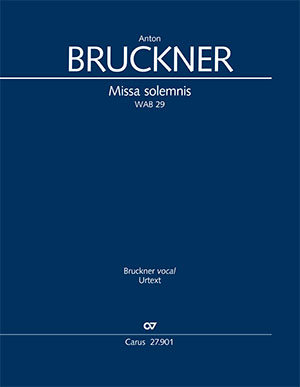
Missa solemnis
WAB 29
Anyone who is familiar with Bruckner’s symphonies and great masses will probably be astonished upon hearing his Missa solemnis of 1854: can the tradition of the Viennese classics still be so clearly evident in a work by Bruckner? And yet, isn’t it also possible to hear much of Bruckner’s later style?
With this edition, the earliest of Bruckner’s orchestral masses is now available as an Urtext edition. It reflects the latest scholarly research, and the complete performance material is available on sale. Compared with Bruckner’s late masses, the demands on chorus and soloists are considerably less. The horns play in just two movements and can be replaced by trombones. This rarely performed work offers many choirs an exciting alternative to the better-known masses – not only for the Bruckner anniversary in 2024!
Here you will find suggestions for intonations to Gloria and Credo: PDF
With this edition, the earliest of Bruckner’s orchestral masses is now available as an Urtext edition. It reflects the latest scholarly research, and the complete performance material is available on sale. Compared with Bruckner’s late masses, the demands on chorus and soloists are considerably less. The horns play in just two movements and can be replaced by trombones. This rarely performed work offers many choirs an exciting alternative to the better-known masses – not only for the Bruckner anniversary in 2024!
Here you will find suggestions for intonations to Gloria and Credo: PDF
Purchase
Additional product information
-
Composer
Anton Bruckner
| 1824-1896Anton Bruckner wurde 1824 in Ansfelden (Österreich) geboren und hatte kein sonderlich einfaches Leben. Der österreichische Komponist stammte aus einfachen, ländlichen Verhältnissen und wurde ein Leben lang von Selbstzweifeln geplagt. Nach dem Tod seines Vaters wurde er im Alter von 13 Jahren als Sängerknabe im Stift Sankt Florian aufgenommen. Nach mehreren Jahren als Schulgehilfe und einem autodidaktischem Orgel- und Klavierstudium arbeitete er zunächst als Organist in Sankt Florian. 1855 wurde er als Domorganist in Linz eingesetzt. Nach einer Einführung in Musiktheorie und Instrumentation durch Simon Sechter und Otto Kitzler, entdeckte Bruckner Richard Wagner als künstlerisches Vorbild, den er zeit seines Lebens bewunderte und auch mehrfach in Bayreuth besuchte.
1868 wurde Anton Bruckner Professor für Generalbass, Kontrapunkt und Orgel am Konservatorium in Wien, zehn Jahre später Hoforganist. 1891 bekam er schließlich einen Ehrendoktor der Wiener Universität. Er galt als wichtiger Orgelvirtuose seiner Epoche, seine kompositorische Anerkennung ließ jedoch auf sich warten. Erst die zwischen 1881 und 1883 entstandene Symphonie Nr.7 in E-Dur mit dem unter dem Eindruck von Wagners Tod entstandenen berühmten Adagio brachte die erhoffte Anerkennung, auch wenn er sie angesichts seiner Tendenz zur Skepsis und Selbstkritik nicht wahrhaben wollte.
Anton Bruckner war ein Einzelgänger, der sich keiner Schule oder Lehrmeinung anschließen wollte. Er schrieb sowohl geistliche als auch weltliche Werke in all ihren Facetten. Neben zahlreichen Motetten komponierte Bruckner drei Messen, die Missa Solemnis b-Moll (1854) und das beim Carus-Verlag erhältliche Te Deum (1881–84; CV 27.190/00). Als Symphoniker schrieb er von 1863 an insgesamt neun Symphonien und viele symphonische Studien, wobei er dazu neigte, fertige Fassungen mehrfach zu überarbeiten. Bruckners Orchesterwerke galten lange als unspielbar, waren aber lediglich für die Tonsprache ihrer Zeit ungewöhnlich kühne, die Traditionen von Beethoven über Wagner bis zur Volksmusik vereinende Klangmonumente an der Grenze von Spätromantik und Moderne. Personal details
-
Editor
Uwe Wolf
| 1961Uwe Wolf studied musicology, history, and historical ancillary science at Tübingen and Göttingen. After receiving his doctorate in 1991 he was a research assistant at the Johann-Sebastian-Bach-Institut in Göttingen. From 2004 he worked at the Bach-Archiv Leipzig. There he directed a both research departments, was substantially responsible for the redisigning of the Bach Museum, and he developed the digital Online-Projekt Bach. Since October 2011 he has been the Chief Editor at Carus-Verlag, Stuttgart. He has taught at various universities and also belongs to the editorial boards of several complete editions. Personal details
Frequent questions about this work
 There are no questions and answers available so far or you were unable to find an answer to your specific question about this work? Then click here and send your specific questions to our Customer Services!
There are no questions and answers available so far or you were unable to find an answer to your specific question about this work? Then click here and send your specific questions to our Customer Services!




